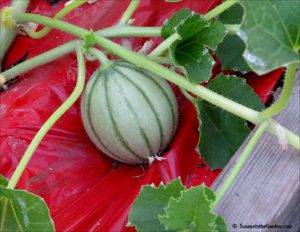Aug. 21 column: Insect ID

Even though I recently wrote a column about the top 5 damaging insects and how to deal with them organically, I decided to write today’s column about the importance of insect ID. Here’s a link to it in The Spokesman-Review: Season’s pests may surprise you. (or you can read my column lower in this post)
If you want to successfully deal with problems in your garden, it is critical that you know first what you’re dealing with so you can come up with a smart strategy.
In my column, I share a problem I was experiencing with my melon seedlings. I was just certain slugs were the culprits since we haven’t had a positive relationship in the past! (grrr) To my surprise, it wasn’t slugs at all but pillbugs instead.
So, there’s a moral to the story in my column along with useful information on where you can get help identifying insects that are bugging you. I hope you’ll enjoy it.
By the way, in my column, I included an information box containing the location, hours, phone number and email address for the Spokane County Master Gardeners. If you read the print version, that information box is missing. However, it did make it to the online edition, so that’s one way to get it.
But just to really make sure you have that information, here it is:
Located at 222 N. Havana St., the Spokane County Master Gardener plant clinic is open from March through October. Hours are 9 a.m. to 3 p.m. Monday-Thursday, 9 a.m. to 1 p.m. Friday, and 9 a.m. to noon Saturday. Contact them at (509) 477-2181 or mastergardener@spokanecounty.org.
Insect ID garden column:
by Susan Mulvihill
In May, I wrote about some of the most bothersome insects in the garden and how to deal with them organically. Since that time, I’ve had an interesting experience with another insect that I wanted to share with you.
When my melon seedlings were about three weeks old, I started noticing problems. The leaves were pale, some had fallen over and, upon closer inspection, the stems had small nibble marks on them.
I immediately suspected slugs since they’ve been my nemesis in the past so I sprang into action. I’ve had good luck using beer traps which involve setting empty tuna cans into the soil and partially filling them with beer. Slugs are attracted to the smell of yeast, come for a sip, fall in and drown.
The morning after setting some traps, I fully expected to see slugs floating in the beer but there was not a single one in sight. I gave it another night but still no slugs. On the third night, I went out to the garden armed with a flashlight to see if I could spy any nefarious activity. To my surprise, pillbugs were crawling on the stems of the seedlings.
Other Master Gardeners have also reported similar problems with pillbugs this season so I knew I wasn’t the only one dealing with this.
Pillbugs are a type of crustacean that primarily feeds on decaying matter so they lead benign lives in the garden — most of the time, that is. While researching them, I learned they also have a penchant for nibbling on the tender stems of young seedlings. Their favorites are melons, cucumbers, squash and pumpkins.
Did this knowledge make me to want to kill every pillbug in my garden? No. It simply taught me to protect my most vulnerable seedlings for the first few weeks of their lives. Once I sprinkled some diatomaceous earth around the base of each seedling, the problem was solved. Diatomaceous earth is the fossilized remains of algae, looks like flour and is harmless to humans. However, it contains tiny sharp edges that cut into an insect’s skin, making it dehydrate and die. I believe it served as a barrier the pillbugs didn’t want to cross.
What’s the lesson here? When dealing with any kind of an insect problem, it’s important to identify the culprit before deciding on with a treatment. Some insects are commonly seen and easy to identify; others can be a mystery. Fortunately, there are folks who can help with this.
The Spokane County Master Gardeners hold a free plant clinic from March through October. Gardeners can either bring in a dead insect for them to identify — which can be done by placing it in the freezer overnight — or email photos to the clinic. Refer to the information box for the location and hours of operation.
To identify an insect, I’ll often conduct a web search first by using search terms like “striped beetle” or “green moth” and viewing the resulting images. Doing this often points me in the right direction. No matter what method you use, remember to identify the problem in order to effectively deal with it and always try organic methods first.
How to get help with insect ID
Located at 222 N. Havana St., the Spokane County Master Gardener plant clinic is open from March through October. Hours are 9 a.m. to 3 p.m. Monday-Thursday, 9 a.m. to 1 p.m. Friday, and 9 a.m. to noon Saturday. Contact them at (509) 477-2181 or mastergardener@spokanecounty.org.

